What is the difference between dry needling and acupuncture?
Dry needling treatment based on western medicine becomes more and more popular in western countries for both acute and chronic pain. Allied health professionals such as chiropractors and physiotherapists integrate dry needling into the treatments.
Myofascial dry needling can enhance the efficiency of treatment. In contrast, Traditional Chinese Medicine (TCM) doctors or acupuncture practitioners apply acupuncture needles to treat a variety of diseases. Acupuncture is commonly used for neck pain, back pain, knee pain and other joint pain. What is the entitle difference between dry needling and acupuncture?
Dry Needling Near Me
Dry needling is an invasive approach that involves inserting acupuncture needles into pain sites or myofascial trigger points. The fine and thin needles used in dry needling treatment and acupuncture are the same. The insertion of the needle can go into different directions in order to elicit the local twitch response (painful response).
The feeling of the local twitch response is similar to the cramping sensation or a sudden muscle contraction. Once this twitch response occurs, the local myofascial trigger point is released.
The myofascial pain will be relieved and the arteries in the skeletal muscles will be dilated. Oxygene and nutrients will follow the blood flow to go into muscles. Waste materials such as carbon dioxide and lactic acid will be taken away from muscles.
A transcutaneous electrical nerve stimulation (TENS) machine can increase the stimulation of tight muscles. Through the pins, the acupuncture needles are connected. Using mild electrical current stimulates the muscle contraction that pumps more blood flow into muscles. Pain relief will occur and hypertonic muscles will be loosened. Joint range of motion could increase after relieving pain.
Acupuncture Near Me – Traditional Chinese Medicine Method
Acupuncture is originated from ancient China that the thin and fine needles are inserted on acupoints. Acupoints are in all over the body lying along meridians and “Qi” is to flow through meridians.
“Qi” is the life force that consists of “yin” and “yang”. Traditional Chinese Medical theory describes that the imbalance of “yin” and “yang” results in illness.
Using the different combination of inserting needles into specific acupoints is believed to treat varied conditions. Needling works as a blockage remover and brings the energy flow back.
Ah Shi acupoints are the special type of acupoints relevant to muscular and skeletal pain. Ah Shi acupoints are tender spots that present similar to myofascial trigger points. The evidence-based research also reveals 95% of Ah Shi acupoint distributions are the same as myofascial trigger points.
When treating muscular and skeletal-related conditions, the same acupoints or trigger points will be chosen. The needles are inserted in the pain sites in both acupuncture and dry needling treatment. A TENS machine can also be used to stimulate acupoints.
The benefits of acupuncture and dry needling definitely outweigh their side effects. Electrical shock is less likely to happen due to the use of mild electrical current only. Soreness could happen after both the side effects of acupuncture and dry needling treatment. The other side effect of needling is possibly a small amount of bleeding.
Service areas of dry needling:
Kings Park NSW 2148
Kings Langley NSW 2147
Quakers Hill NSW 2763
Blacktown NSW 2148
Kellyville NSW 2155
Bella Vista NSW 2153
Rouse Hill NSW 2155
Baulkham Hills NSW 2153
Glenhaven NSW 2156
Dural NSW 2158

